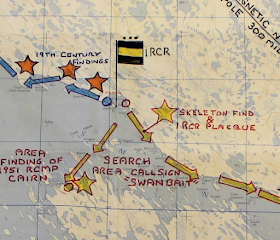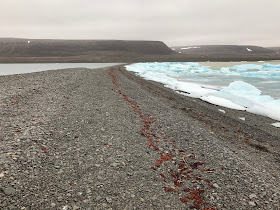As historian Kenn Harper has noted on many occasions, the strong bonds of friendship that tied Charles Francis Hall’s Inuit guides and translators, Ipirvik (“Joe,” whose Inuit name Hall rendered as "Ebierbing") and Tookoolito (“Hannah”) together were extraordinary. As Joe himself put it, several years after Hall’s death, "never be such a good man as Hall again - never so good to me."
And yet, as with any friendship, there were a few rough patches. One of the rougher of these was doubtless the time when, though King William Island lay in reach, Joe and other Inuit refused to take Hall there, as they were worried about persistent accounts of a hostile Inuit band, the "See-neem-e-utes," whose territory lay between them and their goal. Up until recently, we’ve had only Hall’s account of the affair, but a few years ago in the Hall papers at the Smithsonian, I stumbled upon a document that turned out to be a letter — the only one known — written (or rather dictated) by Joe to Henry L. Brevoort, the son of one of Hall’s key supporters. It’s a fascinating document, and touches on many subjects, including Joe and Hannah’s daughter (“Punny go to school every day”), daily life in the home established for them by Sidney O. Budington (“the old man is good friend”), and Joe’s request for some New York cigars, which he declares are the best.
But in the midst of this, Joe recounts, from his own perspective, what happened when Hall's party was forced to turn around, knowing that a return to King William Island would have to be delayed by about nine months:
Joe's letter closes with a poignant and somewhat puzzling series of phrases: "Ebierbing. Joe. Esquimaux. Elonder. Pleas call haff wite man no Esquimaux Joe." Clearly, he did not like the sobriquet "Eskimo Joe," a name that has persisted in popular culture (and as the name of a popular restaurant in Oklahoma), but "Elonder" is a puzzle. His request to "pleas call haff wite man" may similarly reflect a desire to not to be seen as some cultural outsider, rather than as any actual comment on his ancestry.
And yet, as with any friendship, there were a few rough patches. One of the rougher of these was doubtless the time when, though King William Island lay in reach, Joe and other Inuit refused to take Hall there, as they were worried about persistent accounts of a hostile Inuit band, the "See-neem-e-utes," whose territory lay between them and their goal. Up until recently, we’ve had only Hall’s account of the affair, but a few years ago in the Hall papers at the Smithsonian, I stumbled upon a document that turned out to be a letter — the only one known — written (or rather dictated) by Joe to Henry L. Brevoort, the son of one of Hall’s key supporters. It’s a fascinating document, and touches on many subjects, including Joe and Hannah’s daughter (“Punny go to school every day”), daily life in the home established for them by Sidney O. Budington (“the old man is good friend”), and Joe’s request for some New York cigars, which he declares are the best.
But in the midst of this, Joe recounts, from his own perspective, what happened when Hall's party was forced to turn around, knowing that a return to King William Island would have to be delayed by about nine months:
2 years I stay Houdsons Bay try go King William Land then I give it up, meet 3 men from their tell me give it up make me afraid. Mr. Hall tease me all time make me go their never give it up. Next time I go like a soldier every body go so every body carry gun.It's easy to imagine Hall, whose bursts of anger when the Inuit on whom he relied were reluctant to follow his dictates were well-known, being furious at this delay. It seems, though, that whatever rift this may have caused must have eventually healed.
Joe's letter closes with a poignant and somewhat puzzling series of phrases: "Ebierbing. Joe. Esquimaux. Elonder. Pleas call haff wite man no Esquimaux Joe." Clearly, he did not like the sobriquet "Eskimo Joe," a name that has persisted in popular culture (and as the name of a popular restaurant in Oklahoma), but "Elonder" is a puzzle. His request to "pleas call haff wite man" may similarly reflect a desire to not to be seen as some cultural outsider, rather than as any actual comment on his ancestry.



































